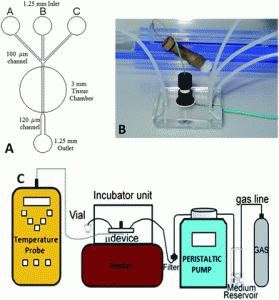Abigail Webster, Charlotte E. Dyer, Stephen J. Haswell and John Greenman
Anal. Methods, 2010, 2, 1005-1007
DOI: 10.1039/C0AY00293C

(A) Channel schematic of the device. (B) Photograph showing the glass microdevice with attached nanoport. (C) General schematic of the assembly showing the pumping system, gassing to media reservoir and flow of the system
John Greenman and colleagues from the University of Hull, UK have developed a new microfluidic device capable of maintaining the long-term culture of viable tissue biopsies.
Culturing tissue biopsies in a microfluidic device provides a more holistic model for detecting cellular response to changes, such as drug stimuli, because the device can accurately reproduce many of the key parameters of the in vivo environment.
This new system has so far been tested with human colorectal tissue biopsies, and demonstrates that tissue samples can be cultured for more than 3 days, currently considered as long-term.
The authors proprose that the simplistic and flexible design of the current device allows real time analytical interrogation of various tissue types. The microfluidic tissue device could then be used for a variety of diverse applications in guiding drug treatment selection in a clinical setting.
This research is timely in driving towards less animal-reliant testing in the pharmaceutical industry and more personalised care in the medical arena.
Read the article for free in the latest issue of Analytical Methods.










